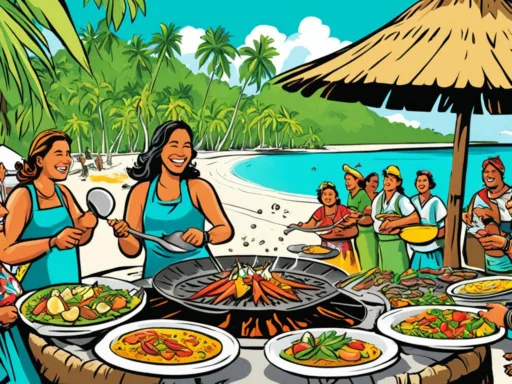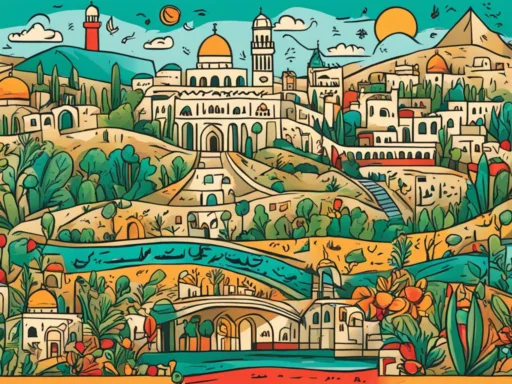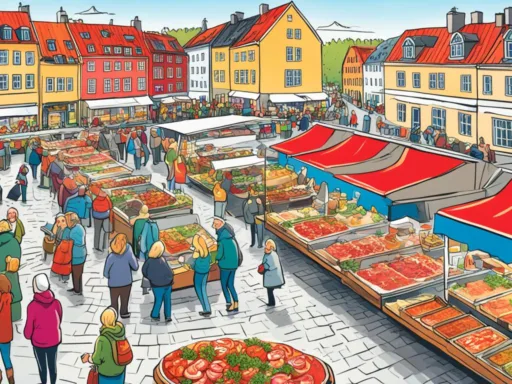While countries often have a single national language, Singapore’s linguistic repertoire bursts with more than just a handful. Believe it or not, this island-nation reverberates with the sounds of over 20 languages daily. The linguistic landscape of Singapore is as diverse as its renowned hawker centers, with four official languages—English, Mandarin, Malay, and Tamil—reflecting the country’s multicultural fabric. Drawing a unique Singapore language map, each of these languages marks territories of ethnic heritage, colonial history, and the intricacies of social interactions among the city’s cosmopolitan dwellers.
Drifting through the busy streets of Singapore, one is enveloped in a symphony of dialects, with English serving as the universal lingua franca that weaves through the various communities. The ‘little red dot’ continues to astound with its tapestry of tongues, from the rich tones of Mandarin and the traditional cadences of Malay to the rhythmic inflections of Tamil, making languages spoken in Singapore a fascinating topic for linguists and travelers alike. The city-state is more than just a business hub; it’s a living language lab where centuries-old dialects meet modern slang, creating a linguistic charm unique to Singapore.
Key Takeaways
- Singapore is known for its rich diversity with over 20 languages spoken across the island.
- English, Mandarin, Malay, and Tamil are the official languages of Singapore, each representing significant cultural groups.
- Unique to the region, Singlish is a colloquial form of English blended with other local languages, often heard in casual settings.
- Historical trading roots and multicultural inhabitants have shaped the linguistic landscape of Singapore.
- The country’s linguistic policies have fostered a society fluent in multiple languages, contributing to its global appeal.
- An understanding of the languages spoken in Singapore is key to grasping the complexities of its social and cultural dynamics.
Linguistic Diversity in the Lion City
The cultural fabric of Singapore is interwoven with a rich tapestry of languages, each contributing to the vibrancy of this urban mosaic. Language diversity in Singapore is not just a happenstance but a reflection of the country’s strategic Singapore language policy, which facilitates a harmonious co-existence of a variety of tongues. From the eclectic hawker centres to the corridors of commerce, languages spoken in Singapore transcend mere communication—they embody the nation’s identity and heritage.
At the heart of this linguistic diversity is the country’s Constitution, which acknowledges Malay as the national language—a nod to the indigenous roots and a statement of cultural importance. Malay serves as a symbol of solidarity for the Malay community whilst encapsulating the historical narrative of the Lion City. Singapore’s commitment to this plurality of languages is also evident in its provision for a multilingual education system which plays a pivotal role in both preserving and promoting this diversity.
Furthermore, English occupies a preeminent position in this linguistic constellation, attributed to Singapore’s colonial past and its contemporary role as a global economic power. Recognized for its instrumental role in governance, law, and education, English serves as the bedrock upon which the foundation for Singapore’s modern advancement is laid. This pragmatic adoption of English as the de facto main language underscores the nation’s forward-looking approach while also acting as a unifying agent amidst the spectrum of languages spoken across the island.
Grasping the intricacies of the Singaporean linguistic matrix reveals over 20 languages that echo through the streets, a legacy of its storied past as an international port of call. These range from dialects of the Chinese, Malay, and Indian communities to those brought by expatriates and international relations. Herein lies the essence of Singapore’s linguistic journey—a thriving medley of Austronesian, Dravidian, Indo-European, and Sino-Tibetan language families that collectively shape the Singaporean voice.
With each language that whispers through the boughs of the banyan or resounds in the marketplaces, Singapore continues to define itself not just as a nation but as a bastion of cultural and linguistic plurality.
Languages Spoken Singapore: A Multicultural Landscape
Singapore’s rich tapestry of languages paints a vibrant picture of its diverse society. Within this dynamic environment, the four official languages of Singapore—English, Mandarin, Malay, and Tamil—each serve a unique purpose and represent the multifaceted heritage of its people. These languages are not just tools of communication, but are deeply interwoven with the cultural and historical threads that make up the Singapore language map.
The Role of English in Singapore’s Language Map
At the heart of the nation’s linguistic matrix is English—an official language of Singapore that has become the main language for business, government, and education. Its widespread use facilitates international relations and trade, shaping Singapore’s global identity. The prevalence of English contributes to the unique Singapore language map that tourist and residents alike navigate daily.
Mandarin’s Influence on Singapore’s Linguistic Landscape
Among the dialects in Singapore, Mandarin holds a significant place, bridging diverse Chinese-speaking communities. Encouraged by government initiatives, Mandarin has steadily reinforced its importance, promoting a sense of identity and unity among Singapore’s Chinese population, and ensuring its influential presence within the broader linguistic landscape of the city-state.
Official Status and Cultural Significance of Malay
Malay, with its official status and symbolic value, anchors the national spirit of Singapore. As the national language of Singapore, Malay underscores the country’s indigenous history and is a touchstone of national pride. Its cultural standing reflects the reverent relationship between the nation’s complex linguistic heritage and its modern-day diversity.
Tamil’s Presence in Singapore’s Diverse Vocabulary
Tamil represents the linguistic identity of the significant South Indian community residing in Singapore. As one of the official languages Singapore embraces, Tamil enriches the city’s cultural makeup, educational provisions, and offers a window into the traditional and contemporary contributions of the Indian diaspora to the Singaporean ethos.
The Evolution of Singapore’s Language Policy
The linguistic landscape of Singapore is as dynamic as its history, with the Singapore language policy witnessing considerable changes since the country’s founding. If we trace the origins, Bazaar Malay was predominantly in use, prevalent amongst the diverse communities for trade and daily interactions. However, the advent of British colonial rule introduced English into the sociocultural fabric, significantly shaping modern Singapore.
Post-independence, Singapore recognized the need to align with the global language economy. English was strategically positioned to catalyze development and foster international relations. This decision was influenced by the broader Singapore language statistics which indicated a surge in the use of English in professional and educational domains.

While English took center stage, there was a parallel movement to standardize the Chinese language within the Chinese community. Mandarin, used by the majority, was promoted to consolidate the diverse dialect groups and maintain linguistic harmony while ensuring cultural preservation. Non-Mandarin Chinese dialects, though rich in heritage, were gradually limited in formal and educational settings under the government’s directive.
The evolution of language policy in Singapore represents a balance between cultural identity and practical necessity. Here’s a look at the linguistic development stages:
| Period | Lingua Franca | Policy Changes | Cultural Impact |
|---|---|---|---|
| Pre-colonial | Bazaar Malay | Emerging trade languages | Multicultural trade interactions |
| Colonial era | English | English introduced by British | Expanded international trade |
| Post-independence | English | English adopted officially | Economic progress, educational advancement |
| Modern Day | English and Mandarin | Governance-led Mandarin promotion | Intercultural communication, global positioning |
The country’s multifaceted approach has not only streamlined communication but also fostered a unique identity, acknowledging its rich ethnic tapestry while reinforcing its stance in the global arena.
Singapore’s Bilingual Blueprint: Navigating Multiple Tongues
In the heart of Southeast Asia, Singapore’s bilingual education policy stands as a hallmark of its commitment to linguistic harmony and cultural retention. Established in the 1960s, this robust framework ensures each student becomes proficient in both English and a mother tongue that reflects their ethnic heritage. As we delve deeper into this policy, it becomes clear that it’s more than a curriculum—it’s an embodiment of Singapore’s dedication to its culturally diverse tapestry.
The Birth of Singapore’s Bilingual Education Policy
It’s a well-known fact that Singapore’s linguistic landscape was sketched by its richly interwoven societal threads. The bilingual education policy gave English a prestigious spot in the academic system while embracing the language of ethnic lineage, be it Mandarin, Malay, or Tamil. This dual-language education system has cultivated a nation of bilingual individuals, capable of engaging both in the global arena and within their cultural communities.

Statistics of Bilingualism: A Country’s Proficiency
The numbers speak volumes. Singapore language statistics reveal a linguistic shift with English increasingly used as the primary language at home. Yet, the proficiency in ethnic mother tongues remains strong, point towards successful implementation of Singapore’s bilingual education policy. The ensuing balance between English dominion in public life and the respect for traditional linguistic identities underscores the triumph of language diversity in Singapore.
Mother Tongue-based Learning in Singapore’s Schools
At the core of the country’s academic institutions lies mother tongue-based learning. A child in Singapore is not simply learning a second language; they are actively engaging with cultural history and values. The curriculum’s structure reflects Singapore’s respect for its ethnolinguistic heritage, and by instilling a mother tongue literacy at an early age, Singapore fortifies its ethnolinguistic diversity against the burgeoning influence of globalization.
| Language | Percentage of Singaporeans Proficient | Status in Singapore’s Education System |
|---|---|---|
| English | 80% | Main Language of Instruction |
| Mandarin | 65% | Primary Mother Tongue Language for Chinese Singaporeans |
| Malay | 15% | Official National Language and Mother Tongue for Malay Singaporeans |
| Tamil | 5% | Primary Mother Tongue Language for Indian Singaporeans |
Official Languages Singapore: Pillars of National Identity
Language is not just a means of communication but also a symbol of cultural and national identity. In Singapore, the mosaic of ethnicities is unified through the official languages Singapore: English, Mandarin, Malay, and Tamil. These languages stand as the bedrock of the nation’s identity, each one embodying the heritage and aspirations of its multicultural society.
Within the confines of Singapore’s Constitution, the recognition of these languages reflects a commitment to language diversity Singapore. English, as the primary language in governance, education, and international affairs, has positioned Singapore on the global stage. Meanwhile, Mandarin serves to integrate the Chinese community, Malay preserves the historical roots, and Tamil provides a voice for the Indian population.
| Role in National Identity | Community Represented | |
|---|---|---|
| English | Global link, education medium | All ethnic groups |
| Mandarin | Unifier of Chinese diaspora | Chinese community |
| Malay | Symbol of national heritage | Malay community |
| Tamil | Cultural representation | Indian community |
The interweaving of these languages not only creates a rich tapestry of linguistic diversity but also fortifies the foundations of Singapore’s unique national character. As learners navigate this polyglot society, they are imbued with a sense of inclusivity and cultural literacy that sets the stage for mutual respect and cohesion.
Each language carries with it the story of a people, the essence of an ethnicity, and the strength of a nation.
Restating the significance of official languages Singapore transcends the mere practicality of communication—it champions the enduring spirit of a nation that celebrates its language diversity as a testament to its collective identity.

Dialects Singapore: Heritage and Contemporary Use
Exploring the language diversity Singapore offers, we delve into the rich tapestry of dialects Singapore has harbored throughout its history. While Mandarin has risen to prominence, the heart of Singapore’s linguistic heritage pulses in its dialects, which continue to manifest in both communal practice and individual identity.
The Shift from Dialects to Mandarin in Chinese Communities
Amongst the Chinese Singaporeans, a linguistic shift was consciously orchestrated to forge unity and international foothold. Singapore’s Speak Mandarin Campaign effectively spotlighted Mandarin at the expense of dialects like Hokkien, Teochew, and Cantonese.
Resurgence of Interest in Chinese Dialects
Yet, a resurgence blooms as younger generations, motivated by curiosity and cultural reclamation, seek to reconnect with their dialect roots. This renewed interest in dialects represents a desire to embrace the full spectrum of language diversity Singapore is renowned for.
Preservation of Indian and Malay Dialects
Equally, Malay and Indian dialects hold their ground in the mosaic of Singapore’s speech. Dialects such as Javanese, Bengali, and Tamil, while more subtly represented, hold profound cultural significance. They afford Singaporeans of Malay and Indian descent a sense of lineage and communal bond.
| Community | Dialect | Cultural Engagement |
|---|---|---|
| Chinese | Hokkien | Cultural classes & festivals |
| Chinese | Cantonese | Theater & culinary traditions |
| Malay | Javanese | Traditional dance & music |
| Indian | Bengali | Poetry readings & community gatherings |
The Singlish Phenomenon: Singapore Language Statistics
While the universal tapestry of Singapore’s language landscape is intricate, Singlish uniquely weaves itself into the social fabric of the country. A colorful creole language, Singlish incorporates English with a pastiche of local dialects and terminologies, reflecting a distinctive Singaporean cultural identity. Singapore language statistics reveal a nuanced pattern of Singlish usage among different age groups, evidencing its resilience against the tides of linguistic standardization.
Despite Singapore’s formal promotion of Standard English, the allure of Singlish is rooted in its expression of camaraderie and local flavor. Here’s a glance at the statistics that illuminate the prevalence of this lingo within the heartland of Singapore:
| Age Group | Frequency of Singlish Use | Proficiency in Singlish |
|---|---|---|
| 18 – 30 | Daily, in informal settings | High |
| 31 – 50 | Regular, often mixed with Standard English | Moderate to High |
| 51 and above | Occasionally, preference for traditional dialects | Moderate |
Singlish stands as a testament to the Singaporean spirit – its adaptability and its embrace of diversity. Nowadays, phrases like “lah”, “leh”, and “can” are more than just slang; they’ve become intrinsic elements of Singapore’s identity, emphasizing the uniqueness of this creole despite the lingua franca status of English. As we explore this phenomenon, we find that the enduring presence of Singlish reflects not just a linguistic choice, but a broader statement of cultural cohesion and pride.
Foreign Influences and Immigrant Languages in Singapore
The cosmopolitan character of Singapore is vividly reflected in its linguistic landscape, not least due to the global connections that have introduced a myriad of foreign languages into its social fabric. As a bustling global city-state, Singapore’s language diversity has been significantly enriched, painting a multicolored canvas of communication and cultural exchange.
The Impact of Globalization on Singapore Language Diversity
Globalization’s relentless stride has invited a constellation of foreign languages to weave into the everyday lives of Singapore’s citizens and residents. Amidst this diverse milieu, expatriates and immigrants contribute to the linguistic landscape Singapore enjoys, with languages like Arabic, Farsi, and an array of European tongues echoing in the corridors of business, education, and community life. This cultural infusion spotlights Singapore language diversity as a benchmark for international cities globally.
Cultural Exchange and the Rise of Foreign Languages
The steady rise of foreign languages within Singapore’s boundaries is testament to the island-nation’s role as a hub for international trade and cultural diplomacy. Thriving in the crossroads of the East and the West, speakers of languages from distant lands enrich the social dialogue and broaden the educational perspective for Singaporeans, who are keenly becoming polyglots in this ever-connected world.
Conclusion
The linguistic tapestry of Singapore is a testament to its rich multicultural ethos. With official languages Singapore is known for—English, Mandarin, Malay, and Tamil—each plays a vital role in the everyday lives of citizens, fostering a sense of unity amidst diversity. The linguistic diversity also extends beyond these four, with a kaleidoscopic array of dialects and immigrant languages contributing to the intricate Singapore language map.
Singapore’s adeptness in balancing cultural heritage with global economic demands is highlighted by its forward-thinking Singapore language policy. Prioritizing bilingualism, the nation has seamlessly integrated the use of languages spoken in Singapore into its educational framework and societal interactions. This strategy not only preserves linguistic and cultural heritage but also equips Singaporeans with the tools to thrive in an increasingly interconnected world.
In the city-state where tradition and modernity coalesce, the polyglot character is a cornerstone of national identity. As Singapore continues to embrace international engagement and cultural inclusivity, it stands out as a role model in crafting language policies that reflect and respect the multilingual reality of its people. Thus, the nation’s linguistic landscape remains a dynamic force, evolving with the times while honoring its storied past.






